Increasing the Participation of People with Disabilities in Engineering Research Centers (Dec 2017)
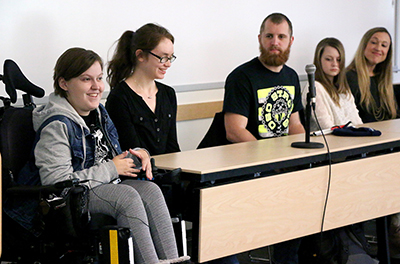
Proceedings of the December 2017 AccessERC Capacity Building Institute: Increasing the Participation of People with Disabilities in Engineering Research Centers
This publication shares the proceedings of the third AccessERC Capacity Building Institute (CBI) entitled Increasing the Participation of People with Disabilities in Engineering Research Centers (ERCs). The content may be useful for people who
- participated in the CBI;
- work on diversity goals within ERCs or postsecondary engineering departments;
- seek to increase their understanding of issues surrounding the participation of individuals with disabilities in ERCs;
- would like to access resources to help make ERC courses, products, and activities more welcoming and accessible to individuals with disabilities; and/or
- have promising practices to share with others.
About AccessERC
The ultimate goal of AccessERC is to increase the participation of people of people with disabilities in science, technology, engineering, and mathematics (STEM), as well as to improve these fields with their perspectives and expertise. Its objectives are (1) to make ERC activities and products welcoming to, accessible to, and usable by people with disabilities and (2) to increase the engagement of individuals with disabilities in ERCs. AccessERC staff work with ERCs across the country to reach the following objectives for ERCs and their collaborating STEM departments:
- Activities: Increase knowledge, skills, and actions in recruiting, accommodating, and engaging people with disabilities in leadership, advisory boards, research teams, internships, presentations, workshops, engineering labs, and other activities.
- Materials: Increase knowledge, skills, and actions in making websites, curriculum materials, online learning, video presentations, engineering labs, and other products more welcoming to, accessible to, and usable by individuals with disabilities.
- Consultation: Offer individual consultation to ERCs regarding accessible products and activities as well as on accommodations for specific individuals with disabilities engaged in their activities and offer ERC participants (and potential ones) with disabilities opportunities to engage in an existing online mentoring and peer support community hosted by DO-IT.
To reach its goals and objectives, AccessERC staff conducts training and community-building activities that include an online community of practice, on-site CBIs, teleconferences, and individual consultation. AccessERC provides financial support to ERCs to conduct relevant activities (e.g., travel to a disability-related conference for staff, a focus group, or a panel of students with disabilities; a guest speaker with a disability; an internship in the ERC; STEM conference attendance for a student with a disability). AccessERC staff also develop and deploy resources to help current and future ERCs work toward reaching project goals and objectives.
AccessERC is funded by the National Science Foundation as a supplement to an existing ERC, the Center for Neurotechnology (CNT), headquartered at the University of Washington in Seattle. The CNT has excelled in the ERC community at including individuals with disabilities in research, leadership, and education. The ultimate impact of AccessERC will be to increase the successful participation of people with disabilities in STEM and improve these fields with their perspectives and expertise.
About the CBI
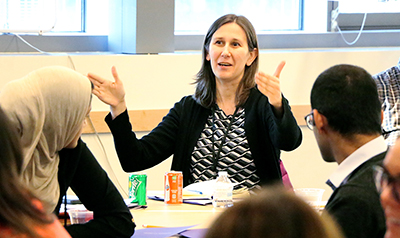
The AccessERC CBI, Increasing the Participation of People with Disabilities in Engineering Research Centers, provided a forum for sharing interventions and strategies that promote the full inclusion of people with disabilities in ERCs. Attendees came from ERCs across the United States. In total, over twenty-five participants were in attendance.
At the CBI participants shared expertise, practices, suggestions for future collaborations, and funding ideas. Broad issues discussed included
- recruiting individuals with disabilities into significant roles;
- understanding disability culture and the history of disability civil rights;
- ensuring the accessibility of ERC websites, curriculum materials, online learning, video presentations, engineering labs, and other products;
- promoting universal design and accessible IT;
- providing reasonable accommodations to individuals with disabilities; and
- exploring opportunities for collaboration.
In small working groups, participants responded to the following questions:
- What strategies used to recruit other underrepresented groups at your ERC could be repurposed for use in recruiting people with disabilities?
- How do the viewpoints of the student panelists and individuals in the documentary Fixed affect how you would communicate with, recruit, welcome, and/or work with people with disabilities in your ERC?
- Where can we link to appropriate resources from our ERC website? What are other ways we can share information within our ERC, including partner institutions?
- How can we continue to work together to promote the participation of people with disabilities in ERCs? What activities could be conducted by Student Leadership Councils?
In this CBI
- all participants contributed to its success;
- experts in many related topic areas were in the audience; and
- new concepts evolved from discussions.
The CBI was comprised of presentations, panel discussions, group discussions, videos, and hand-on activities. The agenda for the CBI and summaries of the presentations are provided on the following pages.
CBI Agenda
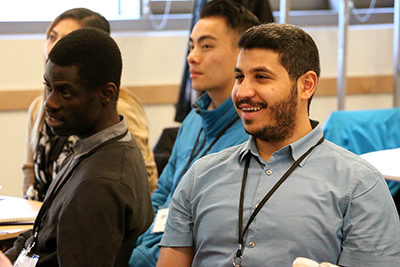
Wednesday, December 6th
6:30 – 8:00pm: Opening Reception & Networking
Thursday, December 7th
7:30 – 8:30am: Breakfast Provided by Marriott Residence Inn
8:30 – 8:40am: Arrive at CNT
8:45 – 9:15am: Welcome and Introductions (CNT)
Chet Moritz, Co-Director of CNT
Sheryl Burgstahler, Director of UW’s Accessible Tech. Services & CNT Diversity
Scott Bellman, CNT Diversity Manager, DO-IT Program Manager
9:15 – 10:00am: Accommodations and Universal Design (CNT)
Sheryl Burgstahler
10 – 10:15am: Video & Publication: Universal Design of an ERC (CNT)
10:15 – 10:45am: Access Technology Used by People with Disabilities (CNT)
Gaby de Jongh, UW Information Technology Accessibility Specialist
11 – 11:30am: Web Accessibility (CNT)
Terrill Thompson, DO-IT Technology Accessibility Specialist, UW
11:40am: Walk to Husky Union Building
12 – 1pm: Working Lunch & Report Out (HUB 334)
What strategies used to recruit/support other underrepresented groups at your ERC could be repurposed for use in recruiting and supporting people with disabilities?
1:00 – 1:20pm: CNT Promising Practices (HUB 334)
Eric Chudler, CNT Executive Director & Education Director
Scott Bellman
1:20 – 2:10pm: Student Perspectives: A Panel Presentation (HUB 334)
Tamitha Tidwell, DO-IT Project Coordinator
2:10 – 2:20pm: Video: Not Your Inspiration – Stella Young (HUB 334)
2:20 – 3pm: Disability Identity and Disability Culture (HUB 334)
Kayla Brown, UW DO-IT Program Coordinator
3:15 – 4:45pm: Film: Fixed: The Science/Fiction of Human Enhancement (HUB 334)
Tim Brown, Paul Tubig, Sara Goering, and Michelle Pham CNT Ethics Team representatives
Discussion: How do viewpoints of student panelists and individuals in the documentary Fixed affect how you communicate with, recruit, welcome and work with people with disabilities in your ERC?
4:45 – 5pm: Video: STEM and People with Disabilities (HUB 334)
6 – 7:30 pm: Dinner
Where can we link to resources from our ERC website? What are other ways we can share information at our ERC, including partner institutions?
Friday, December 8th
7:30 – 8:30am: Breakfast Provided by Marriott Residence Inn
8:50 – 9:00am: Welcome and Introduction to the Day (CNT)
9:00 – 9:05am: Video: Disability Sensitivity Training (CNT)
9:05 – 9:15am: AccessERC Products, Activities, and Initiatives (CNT)
Scott Bellman
9:15 – 11am: Conduct an Accessibility Review of an Engineering Facility
Katherine Pratt, CNT & UW BioRobotics Lab
11 – 11:30am: Action Planning Worksheet & Discussion (CNT)
Sheryl Burgstahler
11:30 – 11:40am: Final Evaluation (CNT)
11:40 – 12:30pm: Lunch (CNT)
Discussion: How can we continue to work together to promote the participation of people with disabilities in ERCs? What activities could be conducted by Student Leadership Councils? By diversity & education leaders? Others?
12:30pm: Wrap Up & Networking (CNT)
Presentation Summaries
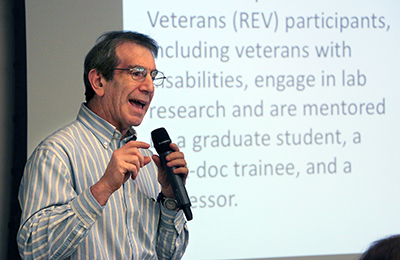
Accommodations and Universal Design
Presenter: Sheryl Burgstahler
Ability exists on a continuum, where all individuals are more or less able to see, hear, walk, read print, communicate verbally, tune out distractions, learn, or manage their health. In K-12 education in the United States, every child is ensured a free, appropriate education in as integrated of a setting as possible. However, in postsecondary education, students must meet whatever course or program requirements apply and are offered reasonable accommodations as needed.
Accommodations and universal design are two approaches to access for people with disabilities. Both strategies contribute to the success of students with disabilities. Accommodations are a reactive process and provide access for a specific student and arise from a medical model of disability. Students might be provided with extra time on tests, books in alternate formats, or sign language interpreters.
In contrast, universal design is a proactive process rooted in a social justice approach to disability and is beneficial to all students. Universal design practices can be used to create products and environments to be usable by everyone, to the greatest extent possible, without the need for adaptation or specialized design. A universal design approach can benefit people who face challenges related to socioeconomic status, race, culture, gender, age, language, or ability. Applying universal design to information technology includes building in accessibility features and also ensuring compatibility with assistive technology. In other words, a universally designed website would, for example, have text alternatives for graphics, present content via both text and visuals, include captions and transcripts for all video and audio content, ensure that all content and navigation can be reached with the keyboard alone, and spell out acronyms.
Universal design of instruction results from an attitude that values diversity, equity, and inclusion. It can be implemented incrementally, focuses on benefits to all students, promotes good teaching practice, does not lower academic standards, and minimizes the need for accommodations. Universal design can be applied to all aspects of instruction, including class climate, interactions, physical environments and products, delivery methods, information resources and technology, feedback, and assessment. Examples include the following:
- Arranging seating so that everyone has a clear line of sight.
- Avoiding stigmatizing a student by drawing undue attention to a difference.
- Using large, bold fonts with high contrast on uncluttered overhead displays
- Speak aloud all content.
- Providing multiple ways to gain and demonstrate knowledge.
- Avoiding unnecessary jargon; defining terms.
- Providing scaffolding tools (e.g., outlines).
- Providing materials in accessible formats.
- Providing corrective opportunities.
- Testing in the same manner in which you teach.
- Minimizing time constraints as appropriate.
Educators who effectively apply universal design and accommodations level the playing field for students with disabilities and make instruction welcoming to, accessible to, and usable by all students. They minimize, but do not eliminate, the need for accommodations.
Universal Design of an ERC
Presenter: Sheryl Burgstahler
ERCs integrate engineering research and education with technological innovation to transform national prosperity, health, and security. As increasing numbers of people with disabilities participate in academic opportunities and careers, the accessibility of courses, labs, electronic resources, events, internships, and other ERC activities increases in importance. Our goal is to provide equal access to everyone who qualifies to use ERC resources and participate in sponsored activities.
AccessERC has created a publication titled Equal Access: Universal Design of Your Engineering Research Center, which contains a checklist for creating a welcoming and accessible ERC. This checklist covers policies and recruitment, information technology, facilities and activities, and various communication methods. Review a copy of this checklist and check out other resources that AccessERC has to offer.
Access Technology Used by People with Disabilities
Presenter: Gaby de Jongh
Assistive technology (AT) is software, hardware, devices, or equipment that is used to increase, maintain, or improve the functional capabilities of individuals with disabilities. AT includes both devices and services. Many “high tech” and “low tech” devices are available to assist people with disabilities overcome barriers to completing daily tasks, such as such as reading and writing documents, communicating with others, and searching for information on the Internet.
People with mobility disabilities use a variety of technologies. Some technology assists individuals with little or no use of their hands in using a standard keyboard. Individuals who have use of one finger, or have access to a mouth- or head-stick or some other pointing device, can control the computer by pressing keys with the pointing device, and software utilities can create “sticky keys” and other options to enhance accessibility.
People who are blind or have low vision can not access visual materials and either need a system that can read text out loud or can create braille with an embosser or a refreshable display. For people who are deaf or hard of hearing, captions and translators are often needed for videos or when interacting with other people. People with learning disabilities use a wide variety of technology depending on their specific disabilities; examples include software that can read text aloud or input text from speech, dictation, and alternative color options.
An example of an individual who uses multiple forms of high tech assistive devices is Stephen Hawking. He uses a combination of eye tracking, augmentative communication device, head array, and power wheelchair; check it out here. For more examples of how computer technology and AT can assist people with disabilities, read the publication Working Together: People with Disabilities and Computer Technology.
Web Accessibility
Presenter: Terrill Thompson
When we’re creating digital content such as web pages, videos, or online documents, we may envision our typical user as an able-bodied person using a desktop computer. In reality, users utilize a wide variety of technologies to access the web including assistive technologies, mobile devices, and more; everyone has different levels of ability when it comes to seeing, hearing, or using a mouse or keyboard. Since the World Wide Web was invented, HTML has had alt tags and other accessibility features as one of its standards. WCAG 2.0 (Web Content Accessibility Guidelines, second version) aims to bring all web content up to an accessible level so that all users have equivalent access. WCAG 2.0 follows four main principles; information should be perceivable, operable, understandable, and robust. Each of these principles is defined by more specific guidelines, and those are further defined by specific success criteria, which are assigned Level A, AA, or AAA, with Level A success criteria including the most critical issues for accessibility. Level A success criteria are fairly easy to meet. In resolution agreements and legal settlements regarding inaccessible IT, the U.S. Department of Justice and the Department of Education Office of Civil Rights have identified WCAG 2.0 Level AA as a reasonable target to ensure websites are accessible.
A push for accessible tools and features will help make all web content more accessible. Using accessible themes in WordPress and Drupal is an easy way to spread accessibility across campus and utilize necessary accessibility features such as keyboard accessible drop-down menus and proper headings. ARIA (Accessible Rich Internet Applications) can be used to analyze accessibility, and it communicates the interface elements to users and designers. Canvas and similar learning management systems need to be made accessible; faculty need to learn about headings and alt text and the right questions to ask about accessibility.
For more information about web accessibility, check out these resources:
- 30 Tips for Improving Web Accessibility
- Accessible Technology at the UW
- Accessible University Demo Site
Promising Practices to Engage People with Disabilities at the CNT
Presenter: Eric Chudler and Scott Bellman
Promising practices of the Center for Neurotechnology (CNT), an ERC at the University of Washington (UW) engage people with disabilities in all aspects of the Center. Further details are available online in a publication called Promising Practices That Engage People with Disabilities in the CNT. The strategies were presented in five broad categories:
- Recruitment and Engagement
- Develop strategic partnerships, including those with disability and veteran service units, and employ joint recruitment strategies.
- Recruit people with disabilities, including veterans, onto advisory boards and leadership teams.
- Develop outreach activities and programs especially for students with disabilities, including veterans, and also recruit individuals with disabilities into programs for all students.
- Communication
- Promote disability awareness.
- Highlight the achievements of people with disabilities.
- Include images of people with disabilities and information on how to request accommodations in promotional materials.
- Encourage faculty, staff, and student leaders to engage in disability-related conferences and training opportunities.
- Share disability-related practices at conferences.
- Accessibility of Facilities, Information Resources, Products, and Activities
- Apply universal design and provide reasonable accommodations.
- Consult with individuals with disabilities in design of labs and facilities.
- Conduct website, document, and video accessibility reviews and remediate.
- An Inclusive Climate
- Consider disability as a diversity issue.
- Provide mentoring opportunities for individuals with disabilities.
- Address disability-related issues in grant proposals to enhance and expand ERC initiatives.
- Data Collection and Evaluation
- Collect disability status along with other demographic information in application and evaluation forms.
- Analyze data to determine the effectiveness of activities for people with disabilities.
Disability Identity: Understanding Disability Culture
Presenter: Kayla Brown
In our society, there are many barriers that prevent people with disabilities from fully participating or feeling included. Faculty and other service providers often address accessibility issues only when determined by disability services or their campuses. Attitudes and stereotypes influence every aspect of the lives of people with disabilities, including social inclusion, educational opportunities, healthcare, self-esteem, and so much more. This presentation covered the following topics:
- Representation of disabilities in mainstream media and social media
- The disability rights movement and signing of the Americans with Disabilities Act
- Prevalent stereotypes about disabilities
- Access to education and the historical oppression of individuals with disabilities
- Grass roots activism and the disability community
- Ableism and victim blaming
- Various models of disability (e.g., social model, medical model, rehabilitation model)
How we define disability and how that contributes to systems of oppression impacting people with disabilities is very important. There is a long history to the disability rights movement that serves to push back on these attitudes and promote the creation of a more welcoming and accessible world.
Conduct an Accessibility Review of an Engineering Facility
Presenter: Scott Bellman
As increasing numbers of people with disabilities pursue educational opportunities in engineering, accessibility of engineering teaching and research labs is critical. The ultimate goal is simply equal access. Hands-on learning in lab courses is an important component of an engineering degree. Everyone who needs to use departmental spaces and labs should be able to do so comfortably.
To make your department accessible, employ principles of universal design. Universal design means that rather than designing your facilities and services for the average user, they are designed for people with a broad range of abilities, ages, reading levels, learning styles, native languages, cultures, and other characteristics. Keep in mind that individuals using a lab may have learning disabilities or visual, speech, hearing, and mobility impairments. Preparing your space and curriculum to be accessible to all will minimize the need for special accommodations.
When designing an engineering facility, consider your planning and policies, evaluation, the physical environment, lab staff knowledge, access to informational resources, equipment and technology, and instructional strategies. To learn more about how to make these aspects accessible, review the brochures Equal Access of an Engineering Department and Equal Access: Universal Design of an Engineering Lab.
As part of this presentation, participants visited the Paul G. Allen Computer Science and Engineering Building to review the University of Washington BioRobotics Lab (brl.ee.washington.edu/). Technology and lab space were reviewed for accessibility using the above checklists.
AccessERC Products, Activities, and Initiatives
Presenter: Scott Bellman
AccessERC is funded by the National Science Foundation as a supplement to the CNT. The ultimate goal of AccessERC is to increase the successful participation of people with disabilities in STEM and improve these fields with their perspectives and expertise.
AccessERC will host Capacity Building Institutes for ERC leaders, maintain a Community of Practice comprised of at least eighty ERC representatives, host regular conference calls, provide consultation to ERCs, offer seed grants for individual activities at ERCs that support project goals and objectives, develop an online Knowledge Base and project website, create case studies of individuals with disabilities who have engaged in ERCs, produce a video promoting replication of project activities, and develop products and publications related to project goals. For more information and to view these materials, visit the AccessERC website.
Summary of CBI Video Presentations
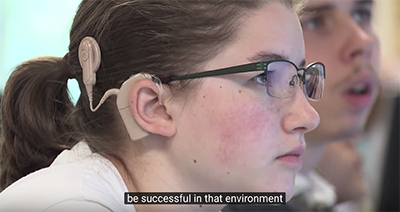
During the CBI, several videos were utilized to share information about disability culture, accessible information technology, disability accommodations, communication tips, and universal design. Find hyperlinked videos below:
Engaging Individuals with Disabilities in an ERC
DO-IT Collaborates with CNT to Open Doors for People with Disabilities
STEM and People with Disabilities
Disability Sensitivity Training Video
Panel: Perspectives of Students with Disabilities
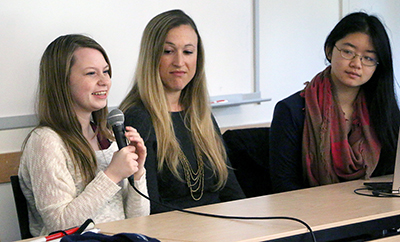
The student perspectives panel featured students with disabilities currently in undergraduate or graduate programs.
- Lindsey, University of Washington, majoring in comparative history of ideas with a focus on disability representation in the media.
- Hannah, University of Washington, majoring in computer science.
- Shawn, Aeronautic University in Prescott, Arizona, majored in Mechanical Engineering with a focus in Propulsion. Now attending University of Washington, majoring in aeronautics with a focus on fluids
- Courtney, Seattle Central, Associate Degree
- Jessie, University of Washington, BS in Informatics
- Jessie, University of Washington, BS in Informatics
What accommodations or technology do you use to be successful?
- I have all my tests and materials created in large print and extra time on tests so I can have time to read it all.
- I use my smart phone for a lot of functions—I use a magnifier, color inversion settings, and sometimes speech recognition programs.
- I need extra time on tests and use a laptop to help me organize my notes and listen at the same time.
- I use Computer Aided Real-Time Transcription (CART), which is live captioning that records everything going on in the room. I also use an FM system, which puts a microphone on the speaker and hooks right into my cochlear implant so I can hear an individual easier.
- I use a scribe to record any notes presented on the whiteboard since I can’t see them. I often ask if a professor can also speak everything they write as well.
- I have to have a lot of my math equations transcribed into braille, which can sometimes be difficult. I also use a braille computer to take notes during class.
- I get extended time on tests and have all of my materials in electronic format. I also have permission to audio record lectures so I can go back and listen to them while viewing diagrams with a magnifier.
- I use speech to text programs (like Dragon Naturally Speaking) to write essays quicker, since my typing is very slow. I also use OneNote to sync all of my notes online and have access to everything I need from my phone.
In what ways have teachers or others tried to over-accommodate you?
- People often ignore my personal space and assume I need help because of my disability. They think they can just grab my arm and lead me somewhere instead of asking if I need help to begin with.
- I’ve often had professors tell me they will just write really big—no matter how big you write, it isn’t going to help me—I need things to be close up to be readable, not big. It is much more helpful to me if my professors just say everything and share diagrams in an electronic format.
- I often have people assume that because I use a wheelchair I must be lost or need help. Just give me a chance to do something myself; otherwise, I can ask for help.
- People often assume I need a sign language interpreter. Just because I’m deaf does not mean I speak sign language or need it. Ask people what they prefer and don’t assume someone needs a specific accommodation until they request it.
What were your experiences in STEM-related classes, and how did that influence your decision to stay or leave a STEM-focused education?
- I was pretty lucky to have professors that were willing to work out any complications, as well as available technology I needed to access information. The biggest struggle I had was with making sure different engineering software products worked with my screen reader.
- Math can sometimes be hard because it is very visual, and sometimes I get lost in long equations until I have a chance to visualize them. Having a note taker in math classes and professors who post their notes really helps me connect what I’m learning in lecture with the actual graphs and formulas.
- I have a note taker; it is especially helpful if the note taker is in your major and knows the class material—having someone with no engineering background take notes in advanced engineering doesn’t work very well since they may not know how to spell certain words or how two topics are related.
- When I took my first computer science programming class, I couldn’t figure out why my code wouldn’t work. Everything read out correctly using my screen reader. Evidently I didn’t use semicolons—I didn’t even know how a semicolon was used in coding because no one had ever explained it—it was always just shown in class.
How many classes do you take a semester/quarter?
- As an undergraduate, I took about five per semester, which was about 15 credits. In graduate school, I take about three, which is still full time.
- I take two to three so I can work part time as well as go to class. I also have an accommodation that gives me the equivalence of being full time even if I’m not technically taking the full 12 credits.
- Currently I take ten credits of evening classes.
- I typically take three classes, which is full time at my school, but next quarter I’m doing an added internship and taking 20 credits.
How do you do lab or field-based research, and did this add more challenges?
- I have taken quite a few lab classes. I usually have an assistant there to help me describe what I’m using or point to where I needed to connect a wire, etc.
- All of my labs have been partner labs, which has been nice because then my partner can do all the tiny detail work where you need to visually see measurements or wires, and I can do all the data collection or synopsis writing. When I worked at the CNT they gave me an enlarged screen, and that was all I really needed to be able to do my computer research on my own.
- I used to work in the makerspace, and I asked that certain equipment be in the exact same location so I could find it. Often things are on wheels and move in these types of labs, which make it much harder for me to find.
How is it different to work with a teaching assistant (TA) compared to a professor?
- Often, the biggest issue is that the information about my accommodation doesn’t get translated well to a TA, so they may not understand that they need to send the testing information to Disability Resources for Students, or may not give me notes in the correct format, etc.
- TAs often know the materials less well, so if I need an accommodation in a lab, they may not have the same answers or options a professor would.
- Professors can sometimes be very rigid in their rules or will forget my accommodations because they’re working with so many students. TAs are closer in age and a lot more understanding, and they’re usually students as well and give me more accommodations or work out a problem together.
Action Planning and Discussion Summaries
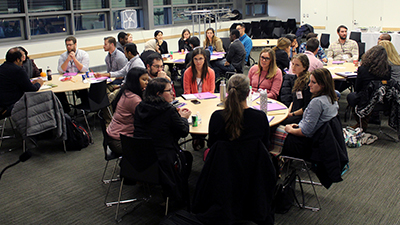
The following are examples of responses given during CBI discussions.
What strategies used to recruit/support other underrepresented groups at your ERC could be repurposed to use in recruiting and supporting people with disabilities?
- Target specific programs and organizations for people with disabilities for outreach activities.
- Create a program to mentor students with disabilities, similar to the programs we have for women and other minorities. Have more peer and near peer mentoring by people with disabilities.
- Invite people with disabilities to be included in diversity panels or give presentations on disability topics.
- Include more people with disabilities in undergraduate summer internships.
- Edit training materials to include accessibility and disability topics, and make sure people with disabilities are represented in imagery in marketing materials.
- Find other resources on campus through minority and disability groups and collaborate.
- Make sure all advertising materials are accessible and include a diverse range of people in images. Have options in digital formats as well.
- Conduct regular reviews of science department and lab space for accessibility.
- Host and participate in more recruiting events targeted at people with disabilities.
- Make sure accessibility is featured on our website and in our brochures.
- Since some projects may be harder for some people with disabilities to undertake, develop an array of projects to allow for a broader group of people to engage and be successful in a lab.
- Outreach to K-12 students with disabilities.
- Make sure all people, including those with disabilities, have opportunities to publish and showcase their work.
Film and Discussion: How do the viewpoints of the student panelists and individuals in the documentary Fixed affect how you would communicate with, recruit, welcome, and/or work with people with disabilities in your ERC?
- Current ERC pipelines are rather narrowly focused—ERCs recruit students from underrepresented groups to help them progress to a PhD, instead of recruiting more widely to give students lab experiences on a more general setting and not expect them to go through a more long-term program.
- Viewing disability as just a variation of human life showcases how we all have different strengths and weaknesses and can contribute uniquely to society.
- Many people with disabilities want different things, and it is important to ask what each person wants instead of making assumptions. Solutions aren’t “one-size-fits-all.”
- I often expected less from people with disabilities and this film and my experiences today have shown me that that expectation is wrong. All people should be treated as equals.
- Fixed is great at showing all sides to the issue, and while there is no true conclusion, it is clear that engineers need more knowledge about designing technology and its impact on people with disabilities.
- Disability is a part of general diversity. Seeking out diverse experiences can be the first step to opening up larger possibilities.
- If we approach disability through universal design, then creating an accessible space can be helpful for all, instead of just accommodating as a quick fix for one student.
- Combining this perspective with the Stella Young video showcased how disability should not be used as inspiration and instead viewed as just another facet of a person. A person should be a role model based on their accomplishments.
- Creating a diversity statement as well as a specific page about disability at the ERC for our website can allow us to be more inclusive.
Where can we link to appropriate resources from our ERC website? What are other ways we can share information within our ERC, including partner institutions?
- Create a new section on our website that shares information about accessibility. Add information to the diversity page and create an accessibility statement linked to from the front page.
- Distribute a one-pager on accessibility information in our ERC and share it with those who come in.
- Host tours on accessibility and do public outreach, sharing information about what makes the lab welcoming to all.
- Add information about accessibility to the ERC’s newsletter.
- Link to AccessERC resources from the ERC’s social media and website.
- Share information across groups within the ERC, including students, post-docs, faculty, and staff.
- Host workshops about disability and accessibility.
- Feature universal design across the ERC website.
How can we continue to work together to promote the participation of people with disabilities in ERCs? What activities could be conducted by Student Leadership Councils (SLCs)? By diversity and education leaders?
- Foster communication and collaboration through in-person meetings and online discussions. Create a community of practice around accessibility as well as around diversity.
- Create and host diversity workshops/panels.
- Have individuals with disabilities lead trainings so students with disabilities can gain mentors and feel included/represented.
- Invite students with disabilities to conduct accessibility walkthroughs of ERC events, websites, labs, etc.
- Promote accessibility practices across institutions and centers; join list-servs and other groups around accessibility and bring those practices to our own ERC.
- Create workshops on implicit bias and how it relates to people with disabilities.
- Create and set up more workshops and events between ERC members and people with disabilities.
- Actively recruit people with disabilities for research experiences for undergraduates (REUs).
- Connect with the Disability Resources Center as well as the Veterans Center to share resources. Connect with other accessibility endeavors across campus.
- Host webinars on disability topics and awareness.
- Student Leadership Councils should have a dedicated diversity chair.
- Promote accessibility training to all faculty, both within the ERC and on campuses.
CBI Participants
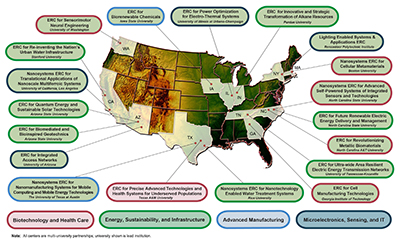
Stakeholder groups represented in the CBI included members of ERCs with a variety of roles. The following individuals participated in the CBI.
Adelowo, Ebenezer
Graduate student
Advanced Self-Powered Systems of Integrated Sensors and Technologies
(ASSIST)
Alrehaili, Omar
Social Committee Chair
Nanotechnology Enabled Water Treatment Systems
(NEWT)
Barrios, Ana C.
Ph.D. Student
Nanotechnology Enabled Water Treatment Systems
(NEWT)
Bellman, Scott
Diversity Manager
Center for Neurotechnology
(CNT)
Borah, Devajani
Student
Center of Bio-mediated & Bio-inspired Geotechnics
(CBBG)
Borela, Rodrigo
Graduate Research Assistant / SLC - Vice President
Center of Bio-mediated & Bio-inspired Geotechnics
(CBBG)
Bronner, Colleen
UC Davis Education Lead
Center of Bio-mediated & Bio-inspired Geotechnics
(CBBG)
Brown, Kayla
Counselor/Coordinator
AccessERC
Burgstahler, Sheryl
Diversity Director
Center for Neurotechnology
(CNT)
Chandler, Jennifer
CBBG Leadership Advisor
Center of Bio-mediated & Bio-inspired Geotechnics
(CBBG)
Chudler, Eric
Education Director
Center for Neurotechnology
(CNT)
Crawford, Lyla
Internal Evaluator
AccessERC
de Jongh, Gaby
Accessibility Specialist
DO-IT
Driscoll, Denise M.
Director of Diversity
Center of Innovative and Strategic Transformation of Alkane Resources
(CISTAR)
Farooqui, Juhi
Post-Baccalaureate Fellow
Center for Neurotechnology
(CNT)
Garcia, Diego
Research Assistant
Re-Inventing the Nation’s Urban Water Infrastructure
(ReNUWIt)
Sara Goering
Philosophy Professor, CNT Ethics Team leader
Center for Neurotechnology
(CNT)
Javed, Hassan
Graduate Student
Nanotechnology Enabled Water Treatment Systems
(NEWT)
Killam, Alex
EE PhD - SLC President
Quantum Energy and Sustainable Solar Technologies
(QESST)
Larson, Jean
Education Coordinator
Center of Bio-mediated & Bio-inspired Geotechnics
(CBBG)
Lanzarini-Lopes, Mariana
Nanotechnology Enabled Water Treatment Systems
(NEWT)
Li, Braden
Graduate Research Assitant
NC State University
Loyo, Jorge
Associate Director of Education
Nanotechnology Enabled Water Treatment Systems
(NEWT)
Lumens, Lynn
Student Organization Leader
NC State University
Moritz, Chet
Deputy Director
Center for Neurotechnology
(CNT)
Newhart, Kate
PhD Student
Re-Inventing the Nation’s Urban Water Infrastructure
(ReNUWIt)
Okpowe, Nelson O.
Graduate Student
Advanced Self-Powered Systems of Integrated Sensors and Technologies
(ASSIST)
Pratt, Katherine
Graduate Student
Center for Neurotechnology
(CNT)
Pruitt, Emmy
Outreach Chair
Nanotechnology Enabled Water Treatment Systems
(NEWT)
Rice, Doug
PhD Student
Nanotechnology Enabled Water Treatment Systems
(NEWT)
Routhier, Alex
SLC Vice-President
Quantum Energy and Sustainable Solar Technologies
(QESST)
Rowlands, Tiffany
Pre College Education and Outreach Coordinator
Quantum Energy and Sustainable Solar Technologies
(QESST)
Saradhi, Vijay
Graduate Research Assistant
Quantum Energy and Sustainable Solar Technologies
(QESST)
Scholes, Rachel
PhD Student
Re-Inventing the Nation’s Urban Water Infrastructure
(ReNUWIt)
Spahr, Katie
D&I Committee Member
Re-Inventing the Nation’s Urban Water Infrastructure
(ReNUWIt)
Thompson, Terrill
Accessibility Specialist
AccessERC
Thyfault, Mackayla
UTEP SLC Vice President
Nanotechnology Enabled Water Treatment Systems
(NEWT)
Tidwell, Tami
Counselor/Coordinator
AccessERC
AccessERC Community of Practice
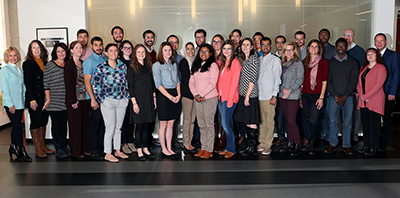
Populated with individuals who work at NSF-funded ERCs across the United States, members of the AccessERC Community of Practice (CoP)
- discuss how to recruit participants with disabilities and accommodate them in their programs and activities;
- recruit their student participants with disabilities into disability-related e-mentoring, internships, and workshops to complement their activities;
- discuss the implementation of universal design to make facilities, products, and activities more welcoming and accessible to individuals with disabilities;
- discuss best practices and resources identified at capacity-building institutes; and
- share ideas about seed grants, new initiatives, and lessons learned.
Individuals can join the AccessERC CoP by contacting doit@uw.edu. For information about other CoPs hosted by DO-IT, consult this page.
Resources
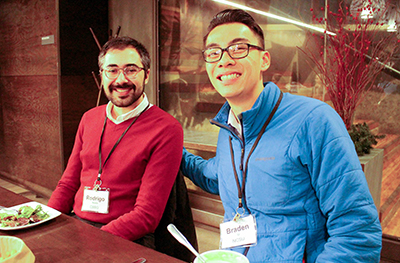
AccessERC maintains a searchable database of frequently asked questions, case studies, and promising practices related to how educators and employers can fully include students with disabilities. The Knowledge Base is an excellent resource for ideas that can be implemented in programs in order to better serve students with disabilities. In particular, the promising practices articles serve to spread the word about practices that show evidence of improving the participation of people with disabilities in postsecondary education.
Examples of Knowledge Base questions include the following:
- Are electronic whiteboards accessible to people with disabilities?
- Are peer review tools accessible?
- Are there computer keyboards designed to be used with only one hand?
- Are touch screens accessible?
- Do postsecondary institutions have to provide assistive technology (for example, screen enlargement or voice recognition software) to students with disabilities who enroll in distance learning courses?
- Does a postsecondary institution have to provide specific hardware or software (known as assistive technology) that an individual with a disability requests so that they can access information technology used on campus?
- Are funds available specifically for captioning?
- Are there any web-based tutorials on web accessibility?
Individuals and organizations are encouraged to propose questions and answers, case studies, and promising practices for the Knowledge Base. Contributions and suggestions can be sent to doit@uw.edu.
For more information on making your campus technology accessible and to learn more about accessible learning or universal design, review the following websites and brochures:
- The University of Washington’s website for information on accessible technology features guides for how to create and develop accessible documents, videos, and websites.
- Accessible University’s website provides common web accessibility principles and solutions.
- Equal Access: Universal Design of Distance Learning Programs provides information on universally designed distance learning programs.
- DO-IT's Accessible Distance Learning webpage supplies tips on what accessible distance learning is and how it helps students.
- The article "Accessible Web Design" educates why accessible web design matters, and provides some resources to make your website accessible.
- The Center for Universal Design in Education provides more information on universal design in education.
- The AccessEngineering website can give further information and resources for specific engineering education.
Acknowledgments
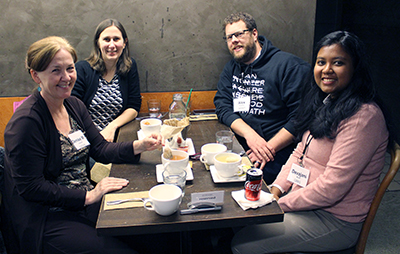
AccessERC capacity building activities are funded by National Science Foundation under Grant #EEC-1028725. Any opinions, findings, and conclusions or recommendations expressed in this material are those of the CBI presenters, attendees, and publication authors and do not necessarily reflect the views of the National Science Foundation or University of Washington.
DO-IT
University of Washington
Box 354842
Seattle, WA 98195-4842
doit@uw.edu
www.washington.edu/doit
206-685-DOIT (3648) (voice/TTY)
888-972-DOIT (3648) (toll free voice/TTY)
206-221-4171 (FAX)
509-328-9331 (voice/TTY) Spokane
Founder and Director: Sheryl Burgstahler, Ph.D.
Program Manager: Scott Bellman
© 2017 University of Washington. Permission is granted to copy this publication for educational, noncommercial purposes, provided the source is acknowledged.